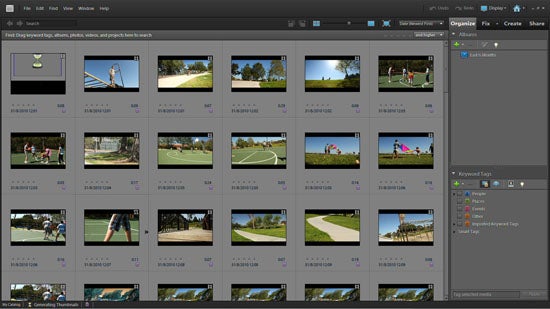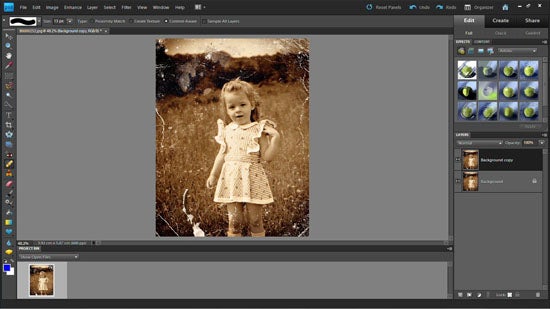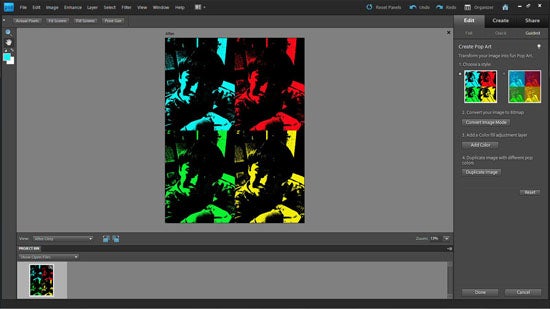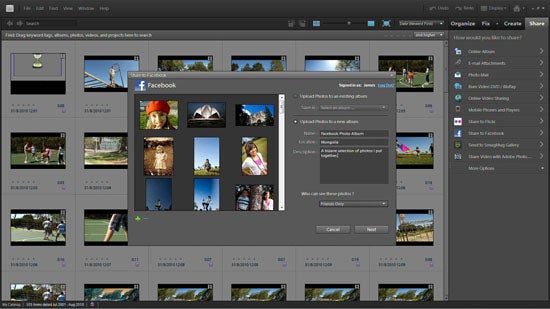Adobe Photoshop Elements 9 Review
Adobe Photoshop Elements 9
The ninth version of Adobe's consumer image editing champion gains yet more sophisticated effects.

Verdict
Key Specifications
- Review Price: £74.52
Photoshop Elements 9 focuses primarily on features, at least for Windows users. The Mac version has now been brought in line completely, so includes the Organizer which PC owners have enjoyed for a few versions. This media management hub provides quick ways to performing simple editing tasks, and includes automatic tagging facilities as well as direct upload to popular online sites, of which more later in this review. The Organizer is almost like an image editing app in its own right.
(centre)The Organizer, previously only for Windows, is now available in the Mac version of Photoshop Elements 9(/centre)
The new Photoshop Elements 9 features are almost entirely focused on extra effects, however. The interface has achieved a well streamlined state, so isn’t in need of significant alteration. Many of the new effects also use Adobe’s Guided Edit system, a wizard-like process which leads you through complicated tasks step by step. This takes some of the complicated capabilities of the full professional Photoshop and makes them accessible to a casual amateur, so they can create sophisticated effects without extensive image editing training.
Not every feature comes with this level of handholding assistance, however. The Spot Healing Brush Tool doesn’t, but it has been improved, and now does a decent job of removing various unwanted elements from your images. You can scrub casual passersby from your public portrait shots, and remove the blemishes from scans of old photos. Obviously, filling in detail which wasn’t originally there isn’t foolproof, and it takes a little trial and error to get right, but the Spot Healing Brush can be surprisingly effective when you’ve grasped the principles. 
(centre)The Spot Healing Brush is useful for removing unwanted elements from your images, such as scratches in old photos(/centre)
A newcomer is the Lomo Camera effect. This lets you create the look of the famous cameras of the same name, using the Guided Edits system to lead you through the process. The Out of Bounds effect also uses Guided Edits to help you crop your photos so that one element is escaping from the frame, such as one of your subject’s limbs. The Pop Art effect leads you through the filtering and reduplication to create the look of an Andy Warhol print. None of these are things you would do all the time, but fun nonetheless. Hence, the inclusion of these effects in the Fun Edits section, and another newcomer here is Reflection. This again uses Guided Editing to help you create its results, in this case realistic mirror images of various different types. You can simulate rippling water, glass or shiny floors, with realistic results.
Adobe’s powerful Photomerge technology has been extended with a couple of new abilities. The Style Match option detects exposure features of your photos, such as the level of contrast or a characteristic colour tone. These can be captured into a profile, which can then be applied to a new image to create a similar look. The other new Photomerge ability is an extension of the Panorama tool. When stitching multiple smaller shots together to make a bigger one, it’s no longer necessary to crop the resulting photo down to avoid missing areas, as Panorama can now fill them in, presumably using similar technology to the Spot Healing Brush.
(centre)A selection of new effects are included which use the step-by-step Guided Editing process, such as this pop art look(/centre)
There is a selection of enhancements to the output phase, too. Recognising the growth of social networking as a means of showing media to friends, the Photoshop Elements Organizer can now output your photo albums directly to Facebook via its Share tab. If your Elements album contains videos, these can be uploaded too, although only one at a time. You need to authorise Photoshop Elements with Facebook, but then Organizer can upload photos to new or existing Facebook albums, and configure who has access to the images.
The Create section of the Organizer has the ability to work in basic and advanced modes. In the former configuration, you simply choose the type of creation you want to put together and the photos you want to use, then Elements will populate the creation for you. In advanced mode, you can access the full Photoshop Elements feature set to adjust and customise how your images are displayed in your creation. So you can edit the images from directly within the layout, which is handy if you want to adjust your photos to fit the arrangement.
(centre)You can upload your photos directly to a Facebook album from the Organizer(/centre)
If you’re creating a framed montage, there is much more flexibility available. You can resize your photos and change the position. It’s also possible to reconfigure the layout or swap the background. The printing process has been enhanced as well, with a friendly interface giving you access to printer settings such as paper size and type or print size, rather than the basic one available from your printer’s driver.
As an added bonus for those using computers equipped with multi-touch trackpads, Photoshop Elements now has direct support for finger gestures, such as pinch to zoom and dual-finger rotating. This includes PCs as well as Macs.
Verdict
Adobe Photoshop Elements 9 is not a really huge leap forward over version 8, and existing users may not find the essential feature here which makes the upgrade worthwhile, unless they’re using a Mac, in which case the Organizer’s facilities could be just what you need. But users of earlier versions than 8 have plenty of reasons to step up, and if you are currently using a more modest image editing app or nothing at all, it will be well worth the expenditure. Because, after all, Adobe Photoshop Elements 9 is an even more powerful version of the most accomplished consumer-grade image editing software on the market.
Trusted Score
Score in detail
-
Features 10
-
Value 9
-
Performance 10
-
Design 9
Features
| Media Format | DVD-ROM |
| Program Type | Image Editing |
| Max Licensed Users | 1 User |
| System Requirements | For PC: Processor: 1.6 GHz or faster Operating System: Windows XP with Service Pack 2 or 3 Windows Vista Windows 7 Hard Disk: 3 GB (additional free space required during installation) Memory: 1 GB RAM (2 GB for HD video functions) Optical Drive: DVD-ROM Others: Color monitor with 16-bit color video card 1024x576 display resolution at 96dpi or less DirectX 9 compatible display driver QuickTime 7 software (required if importing QuickTime formats) Internet connection required for Internet-based services For Mac: Processor: Multicore Intel Operating System: Mac OS X v.10.5.8 through v.10.6 Hard Disk: 3.4 GB (additional free space required during installation) Memory: 1 GB RAM (2 GB for HD video functions) Optical Drive: DVD-ROM Others: 1024x768 display resolution QuickTime 7 software (required if importing QuickTime formats) Internet connection required for Internet-based services |


